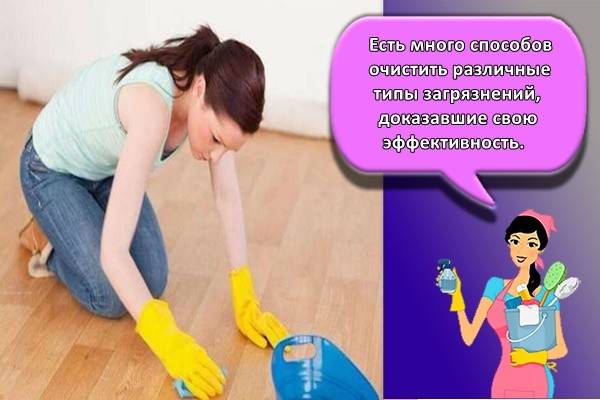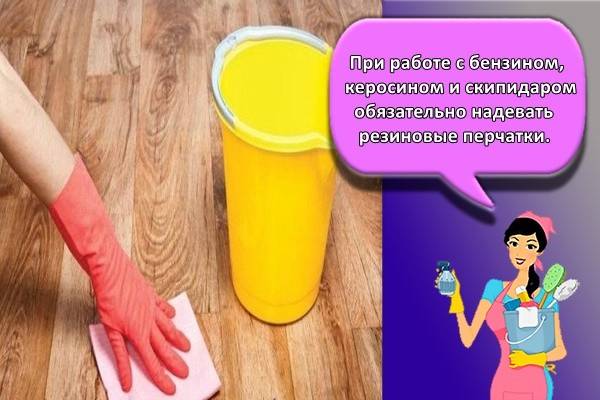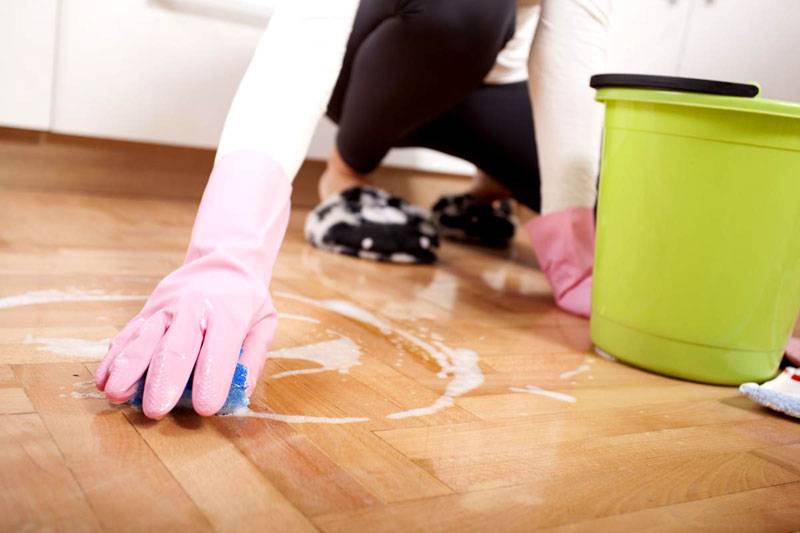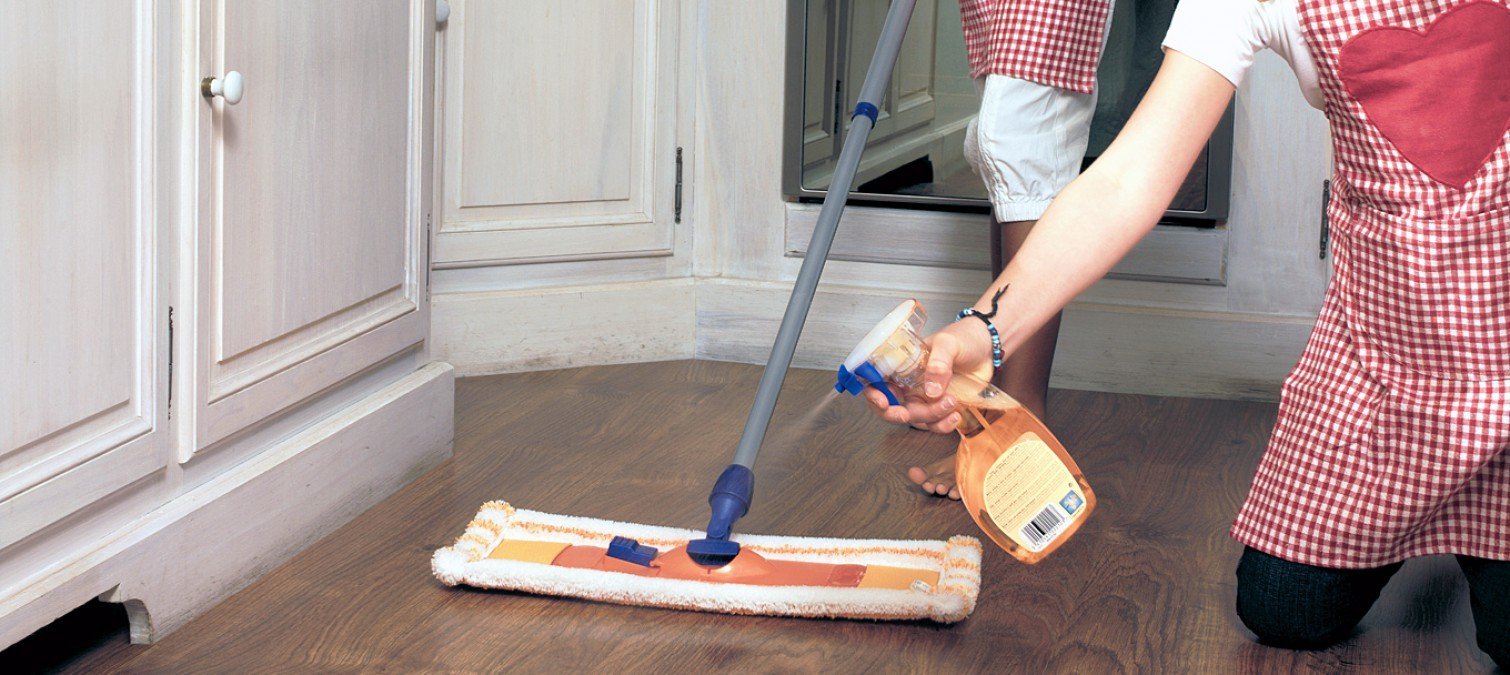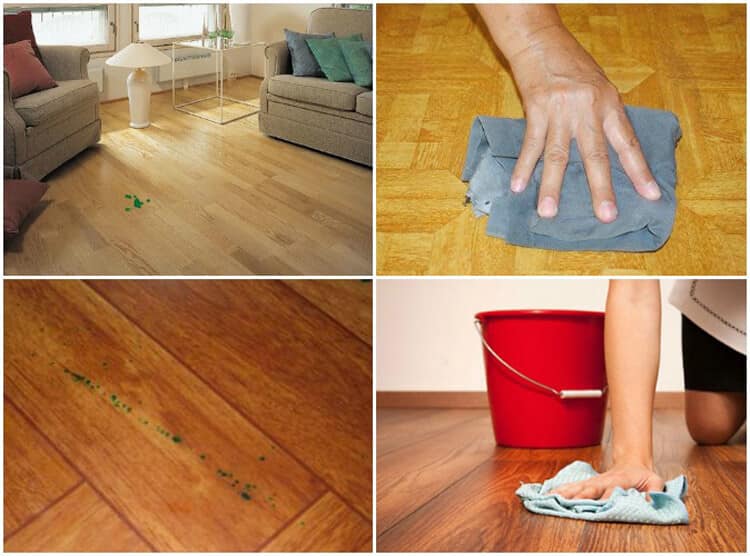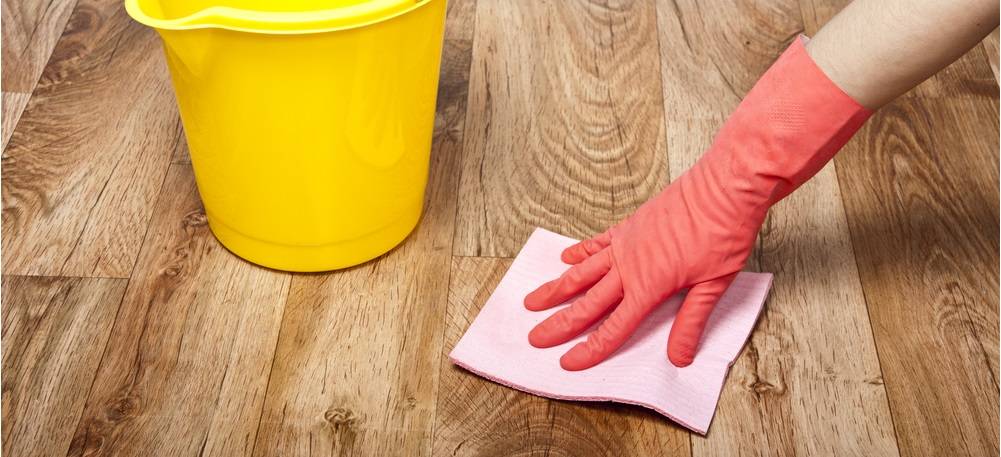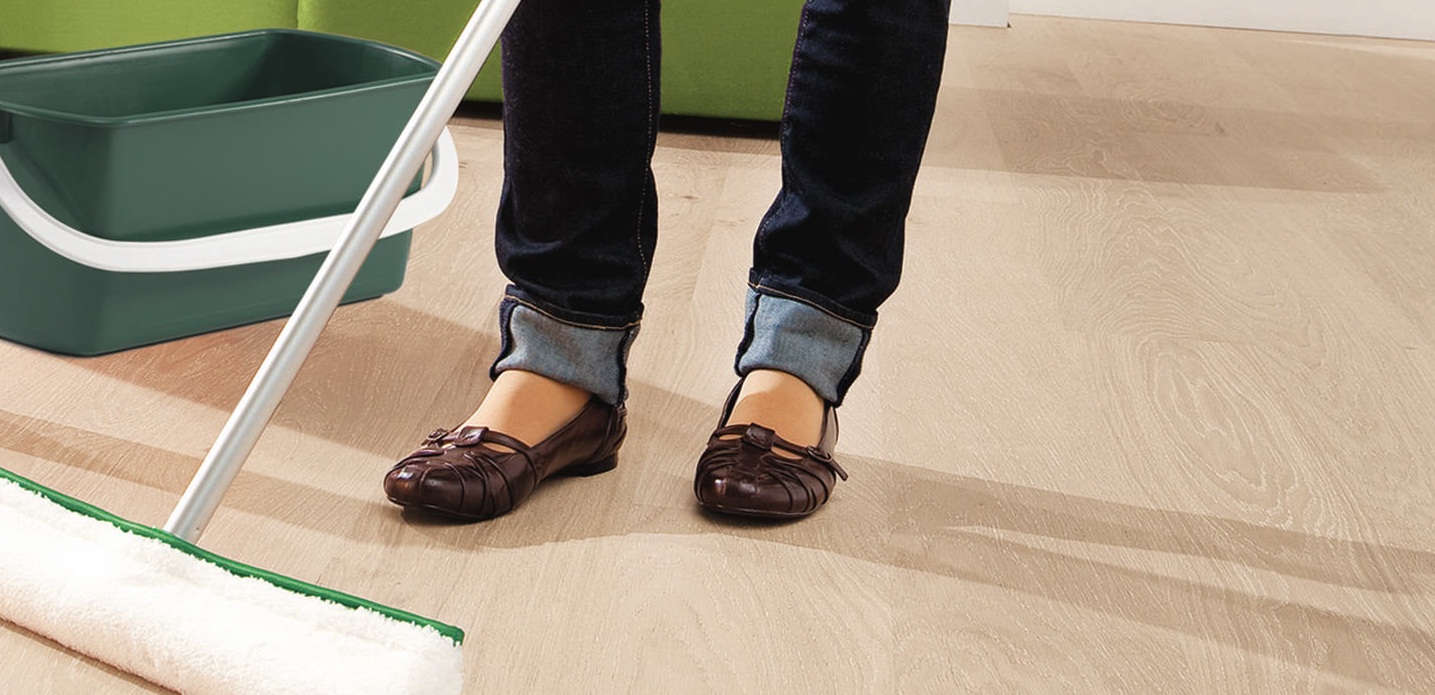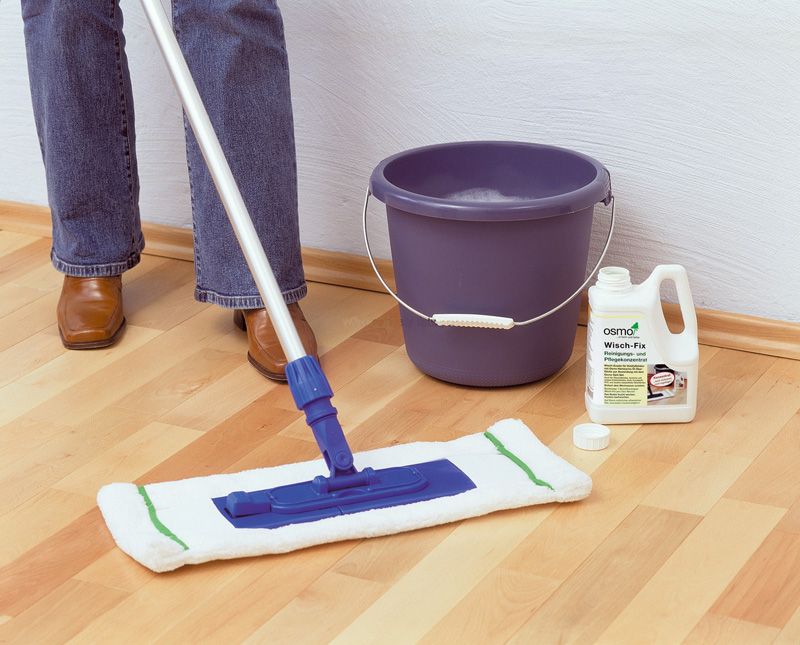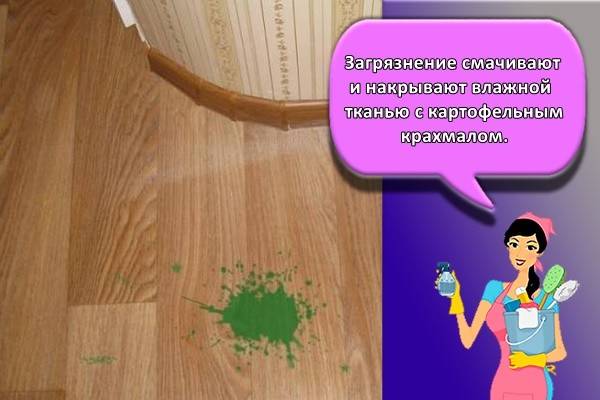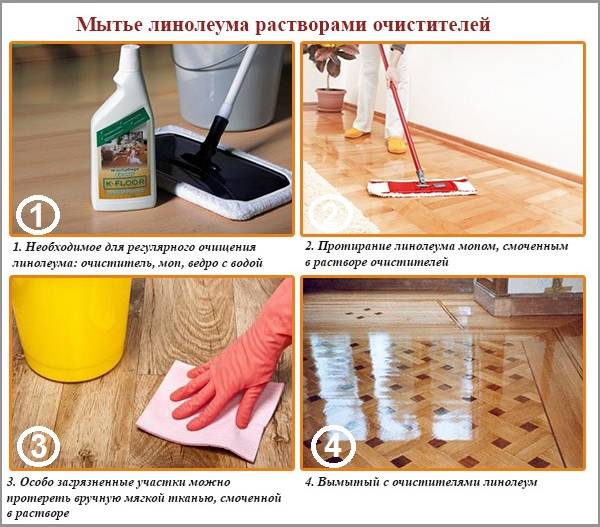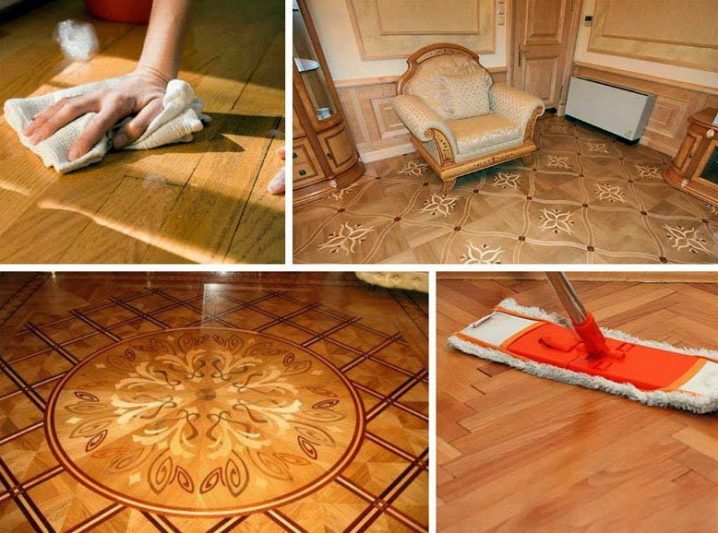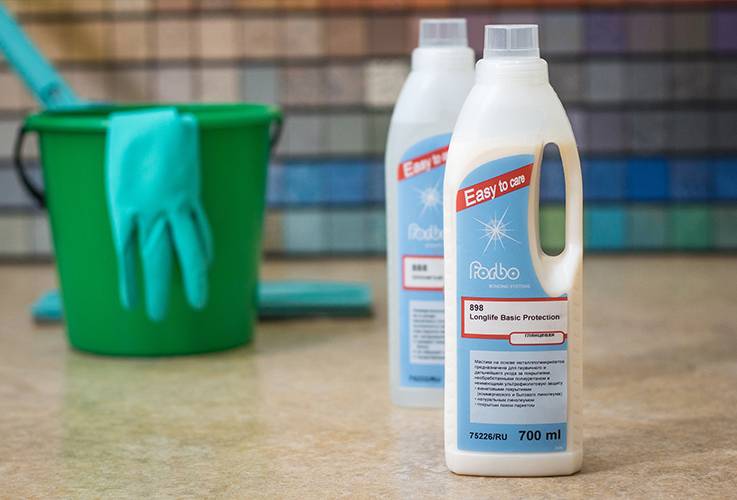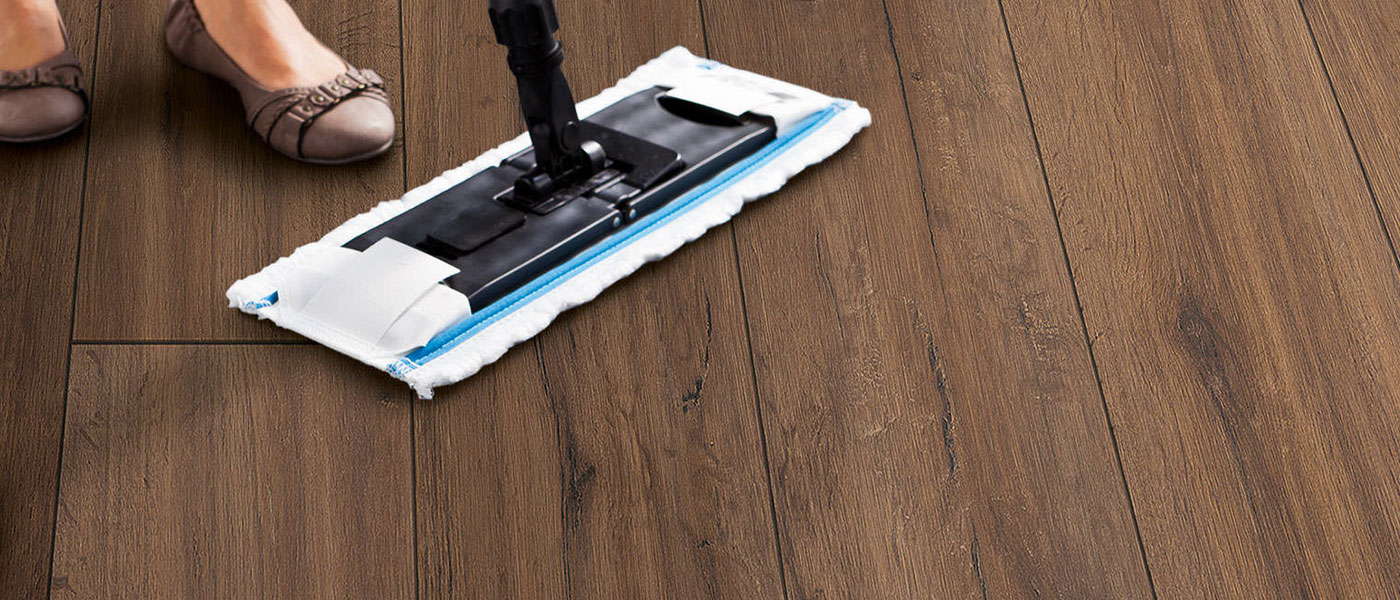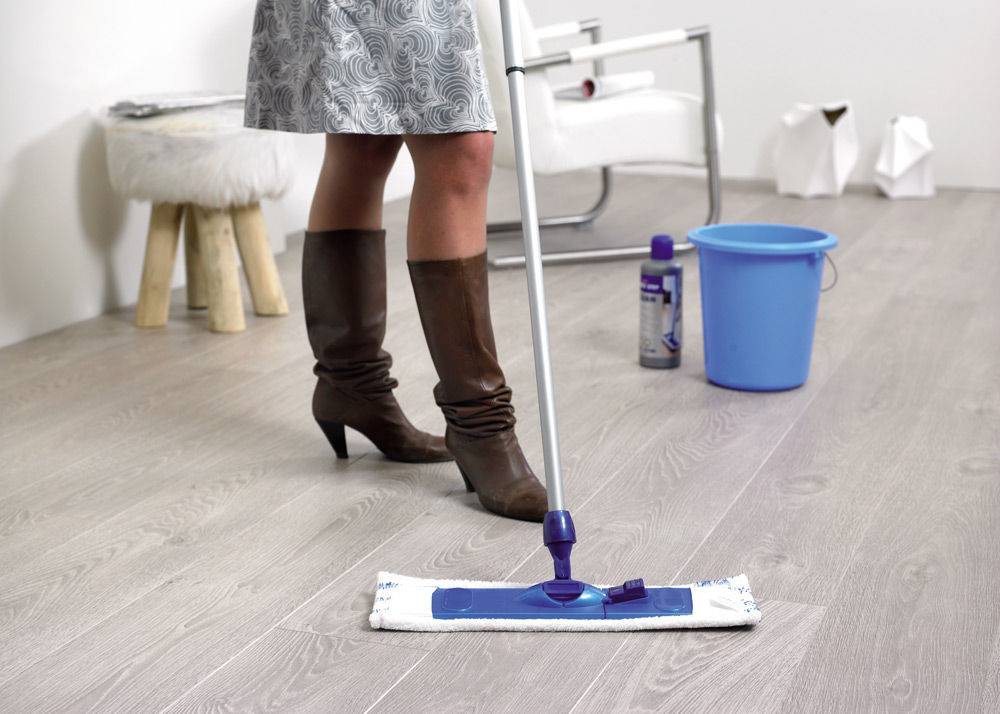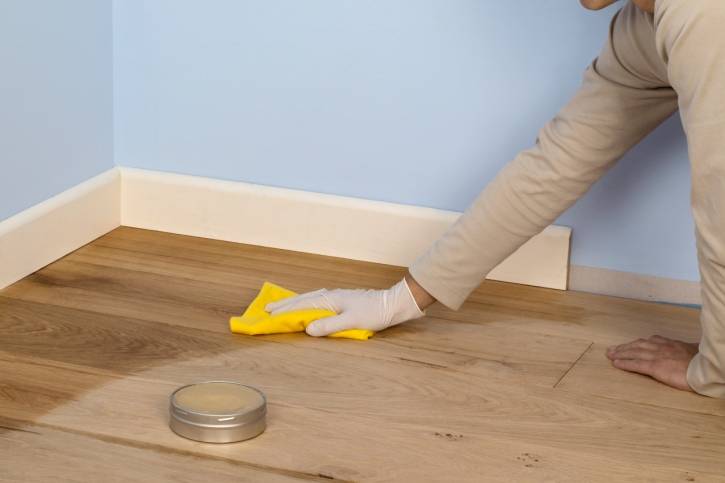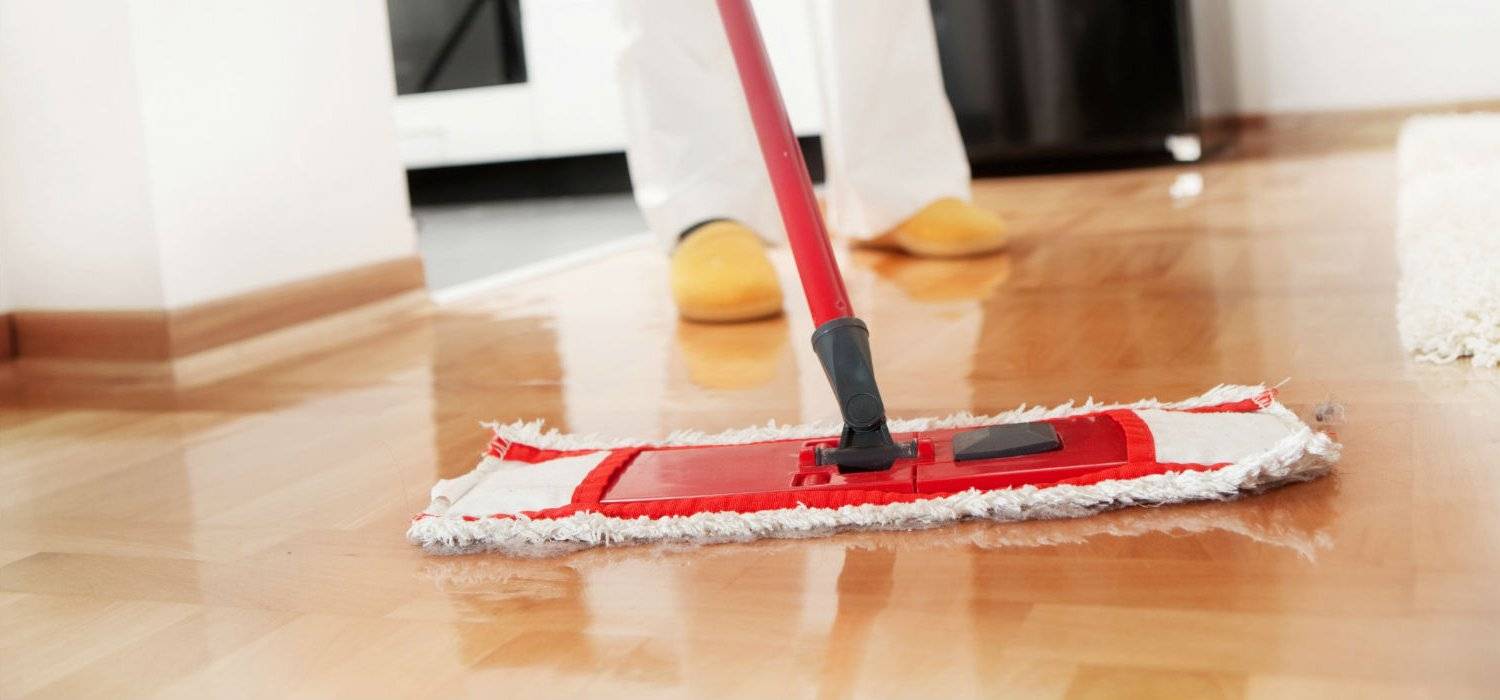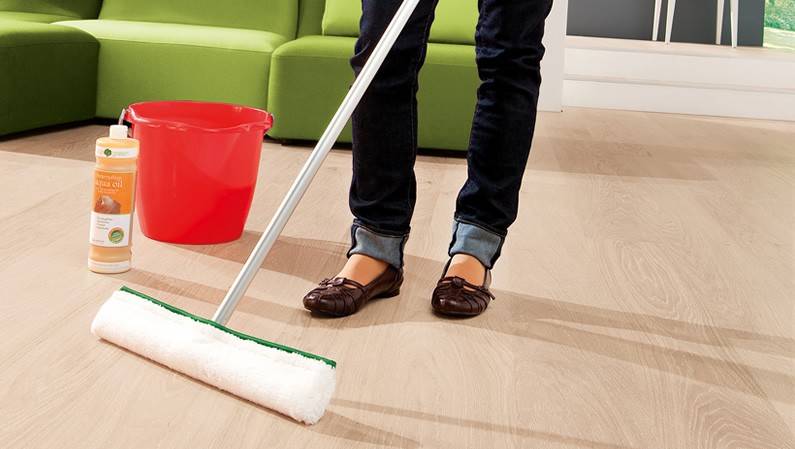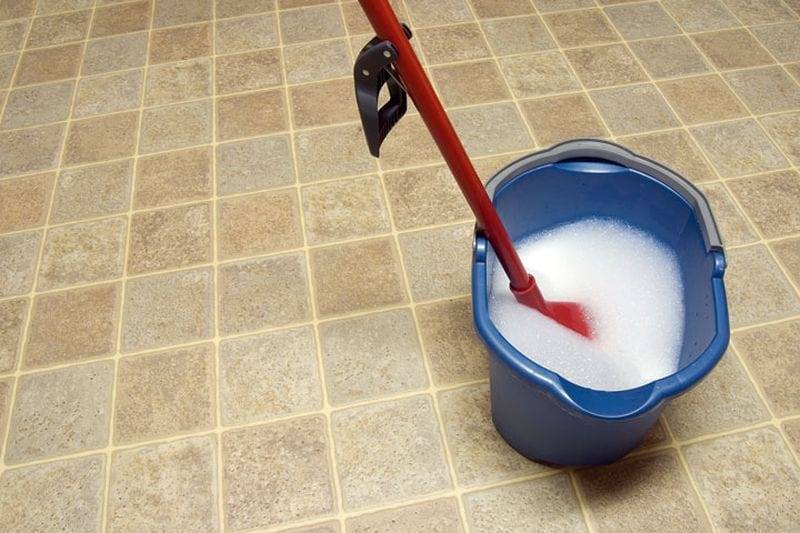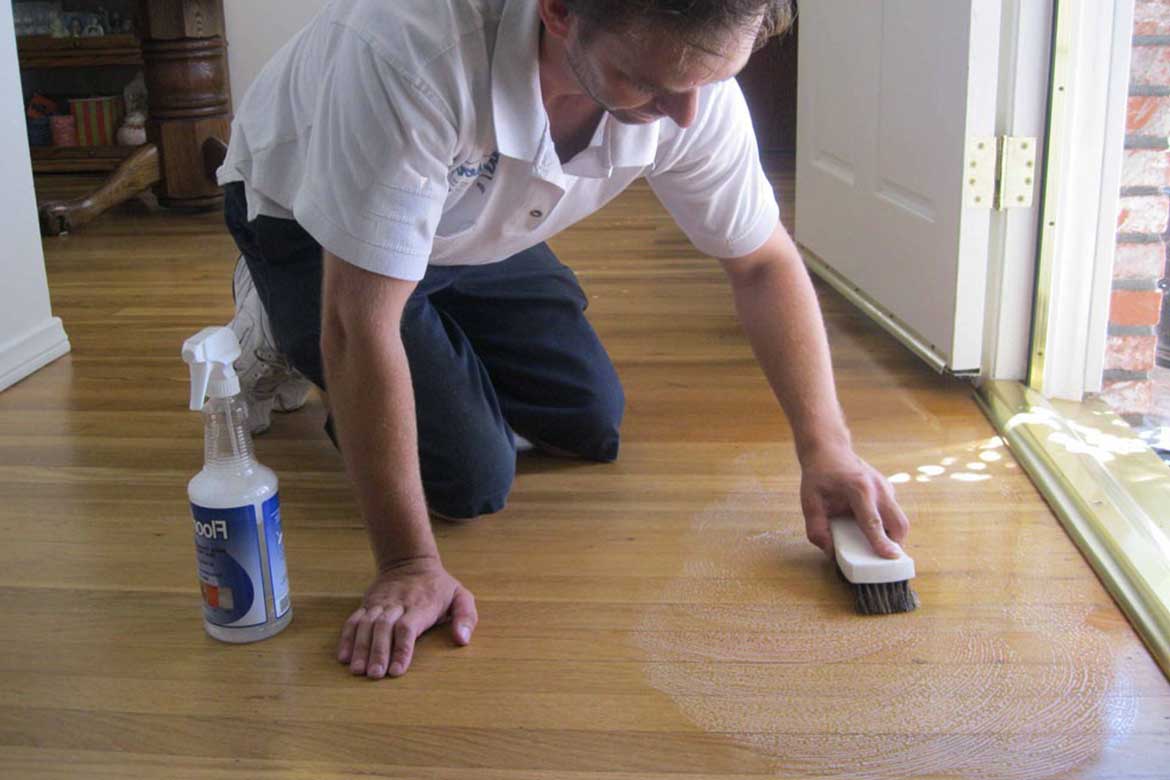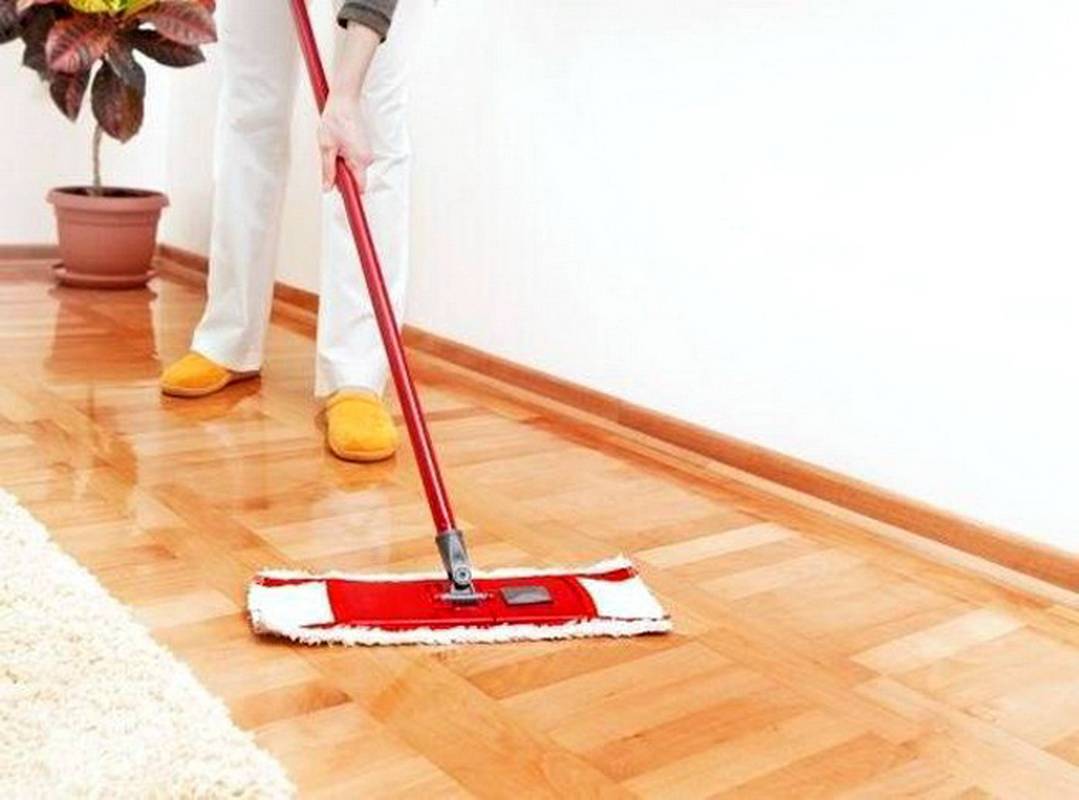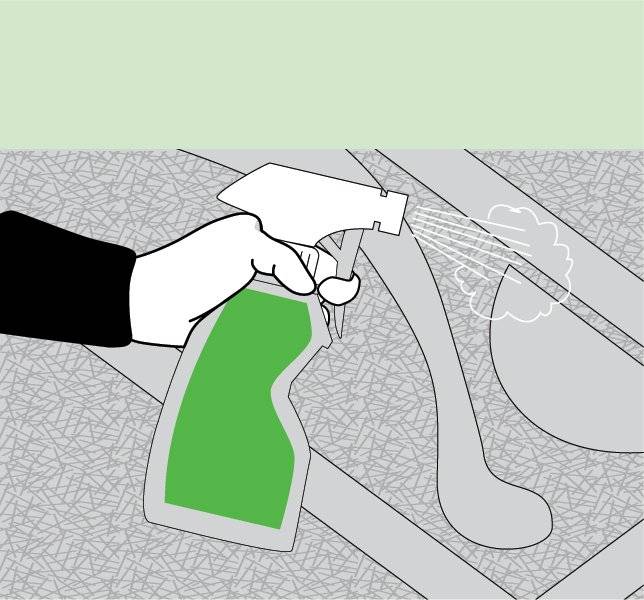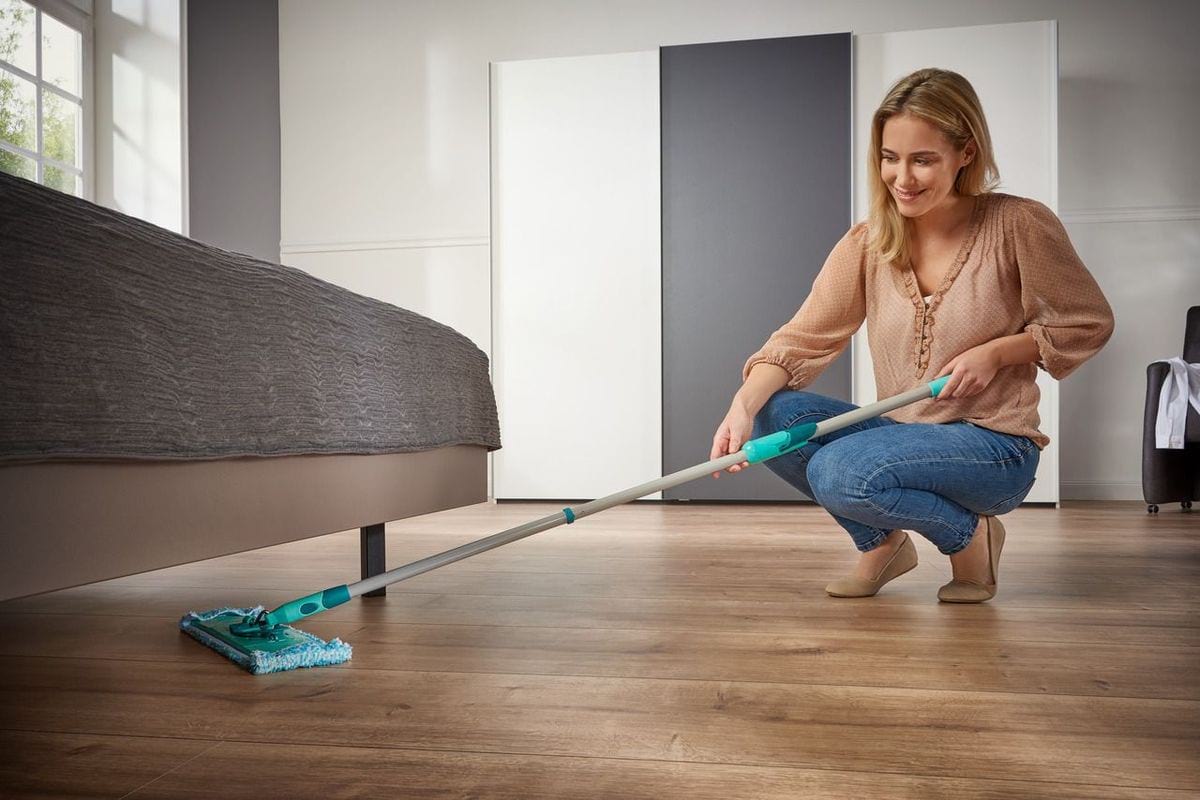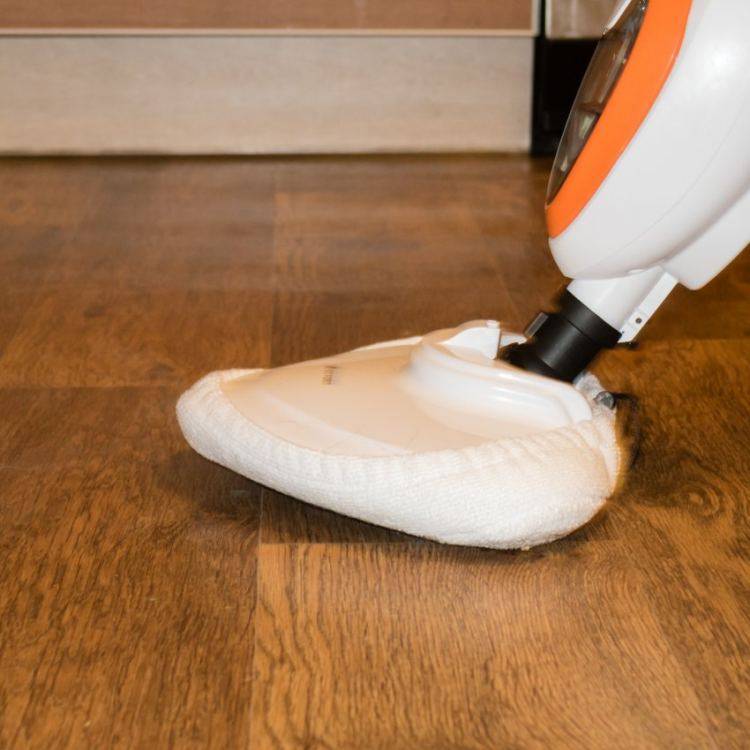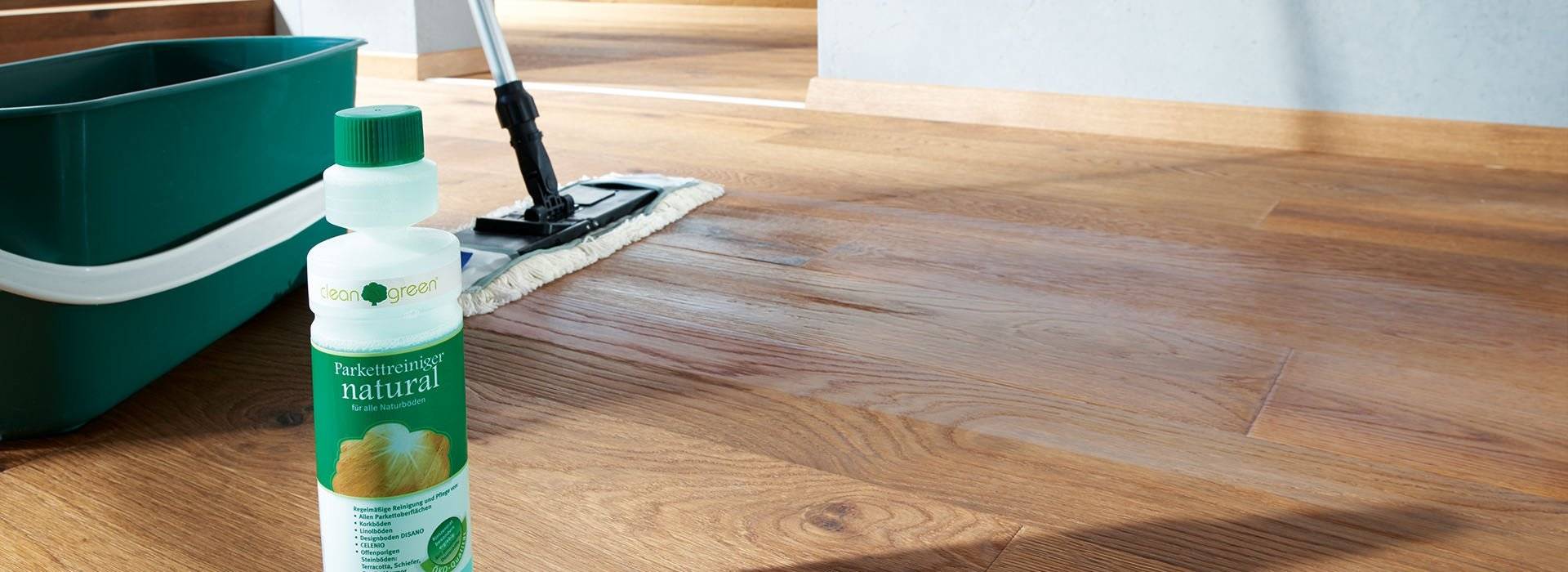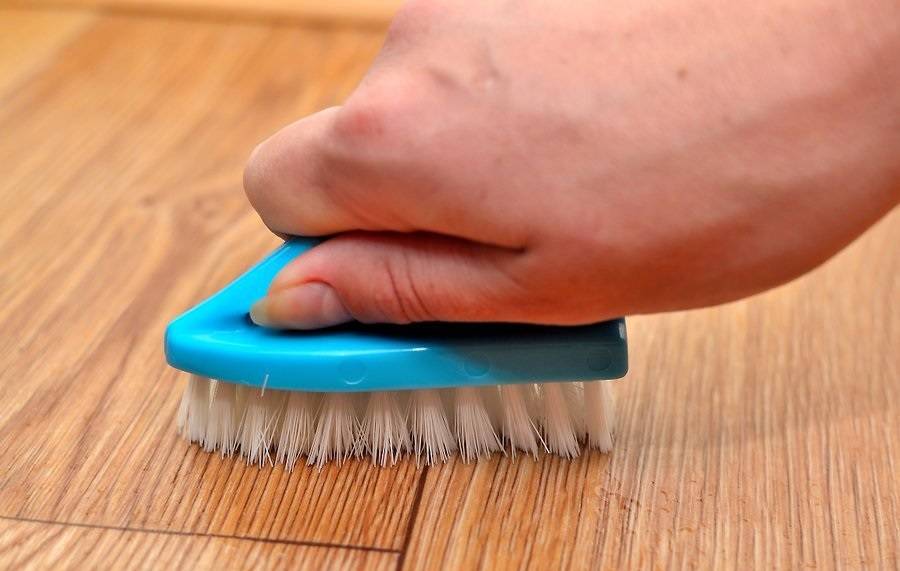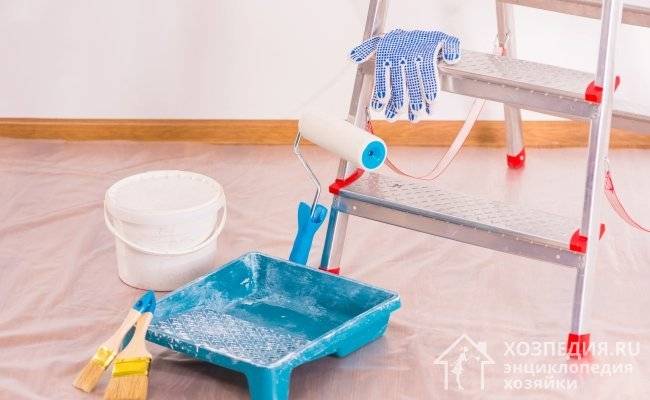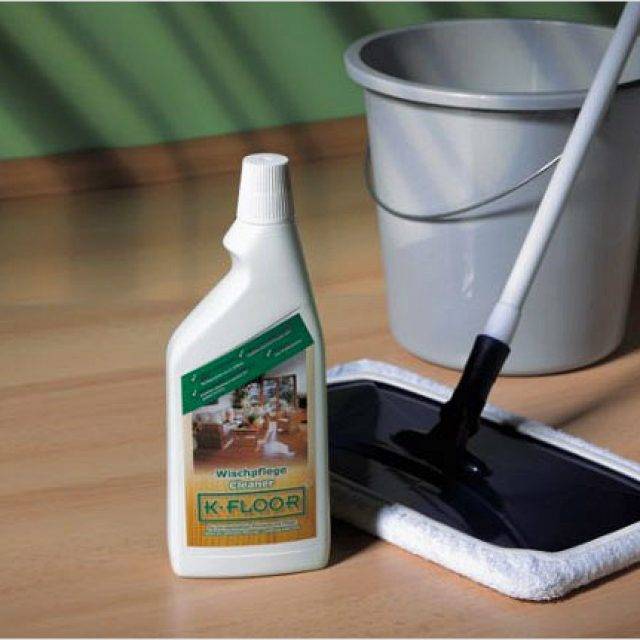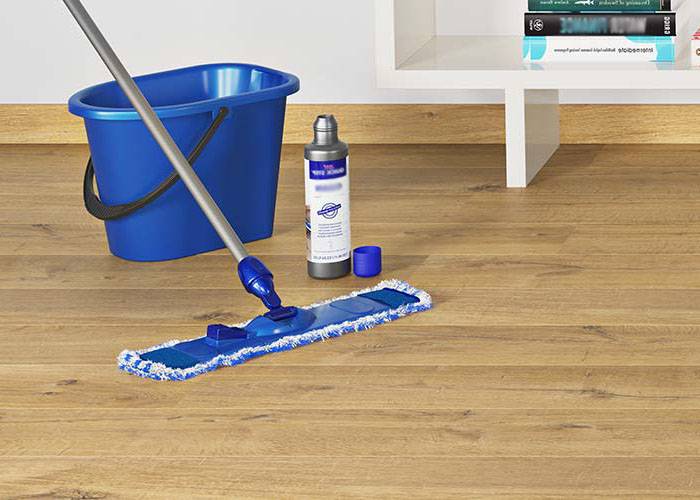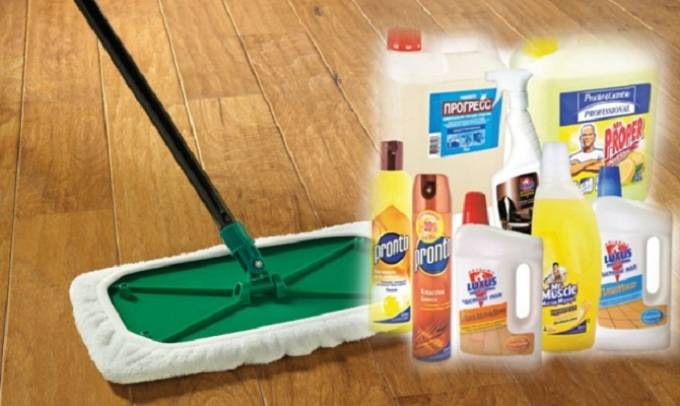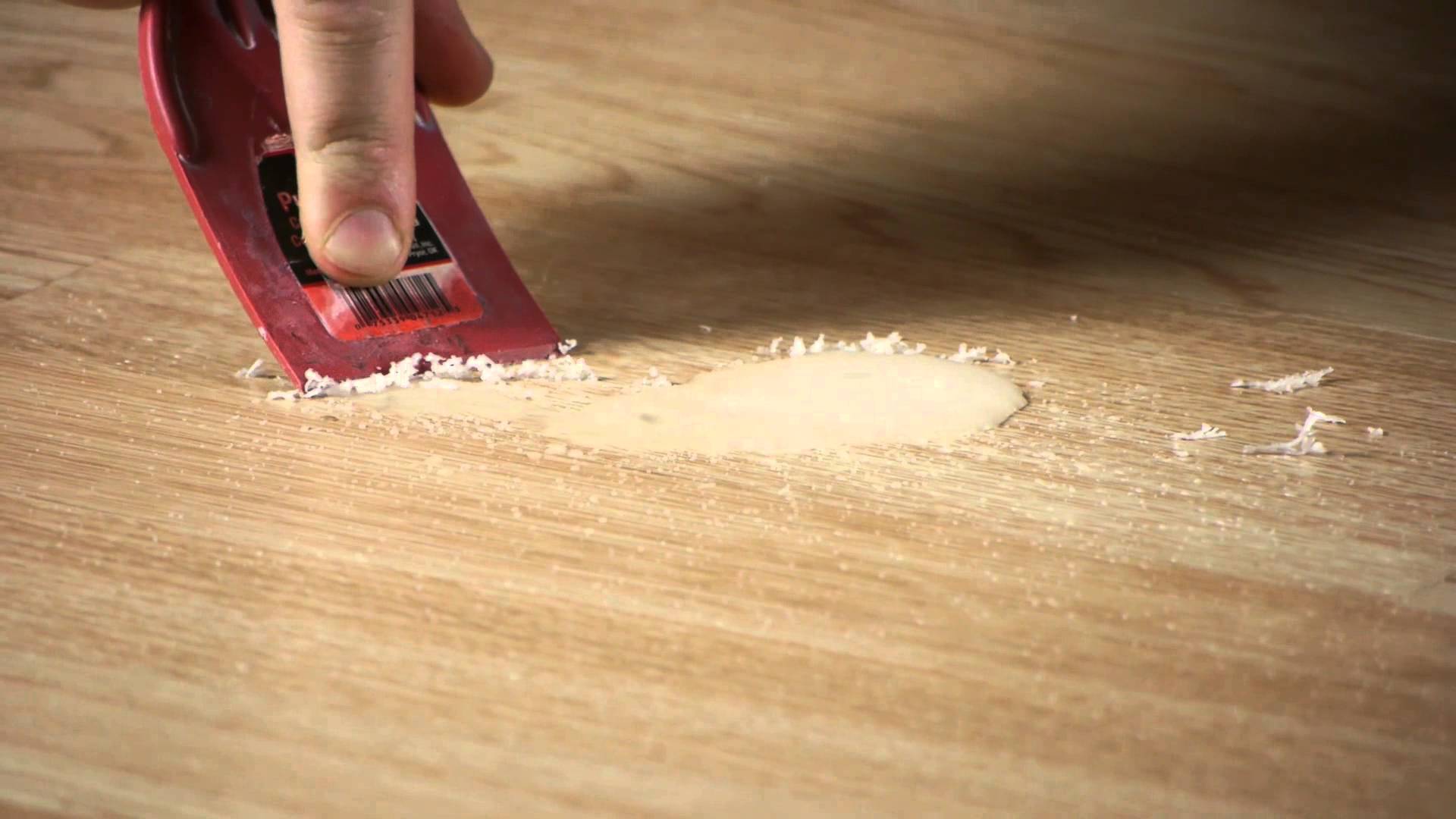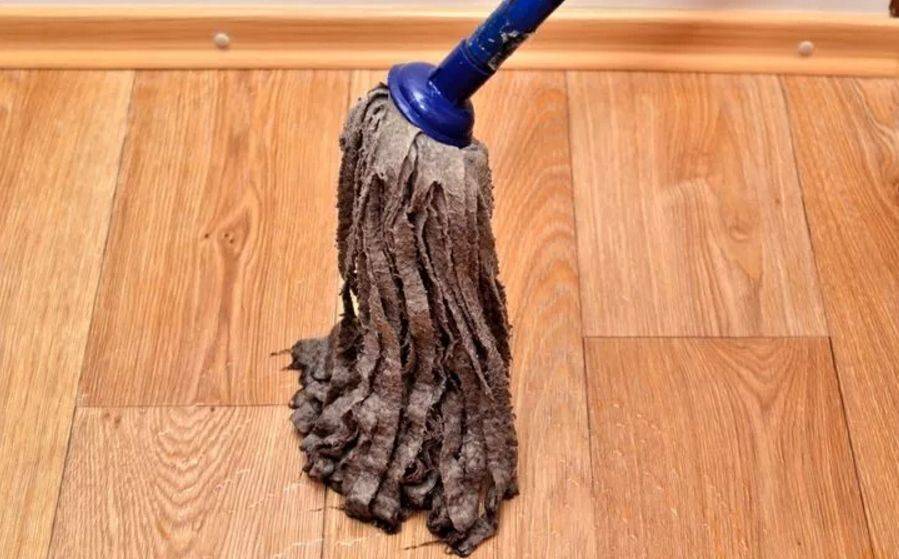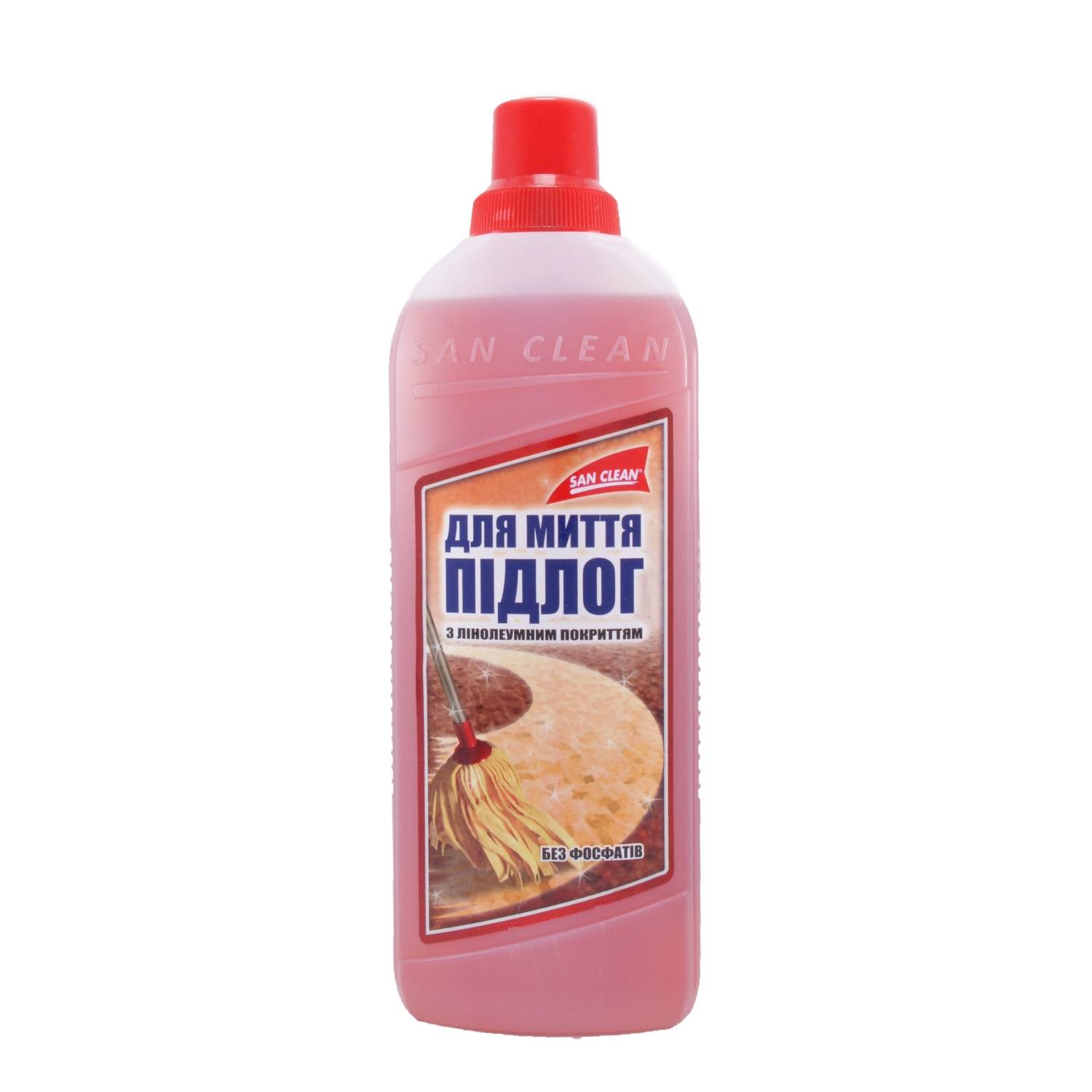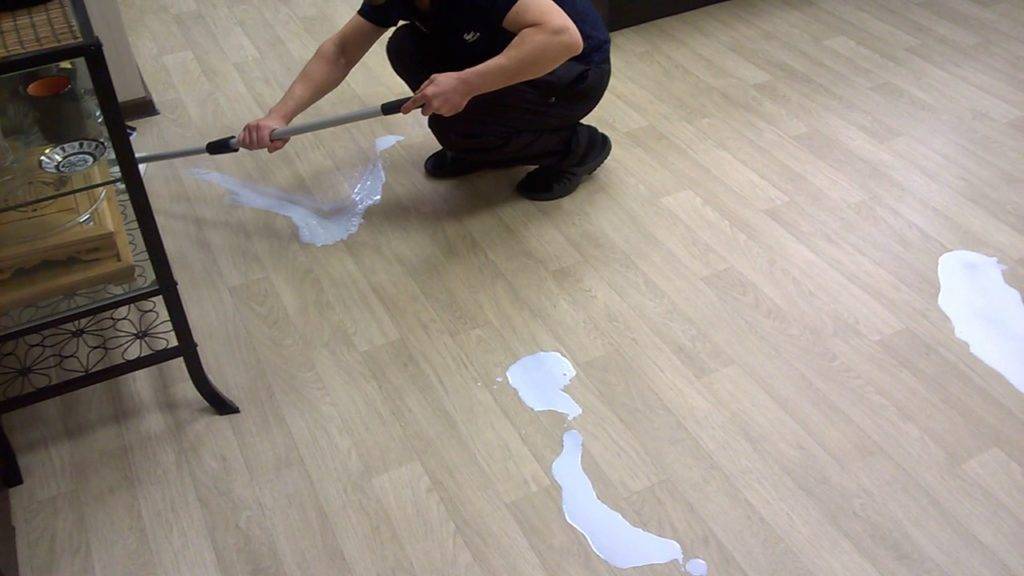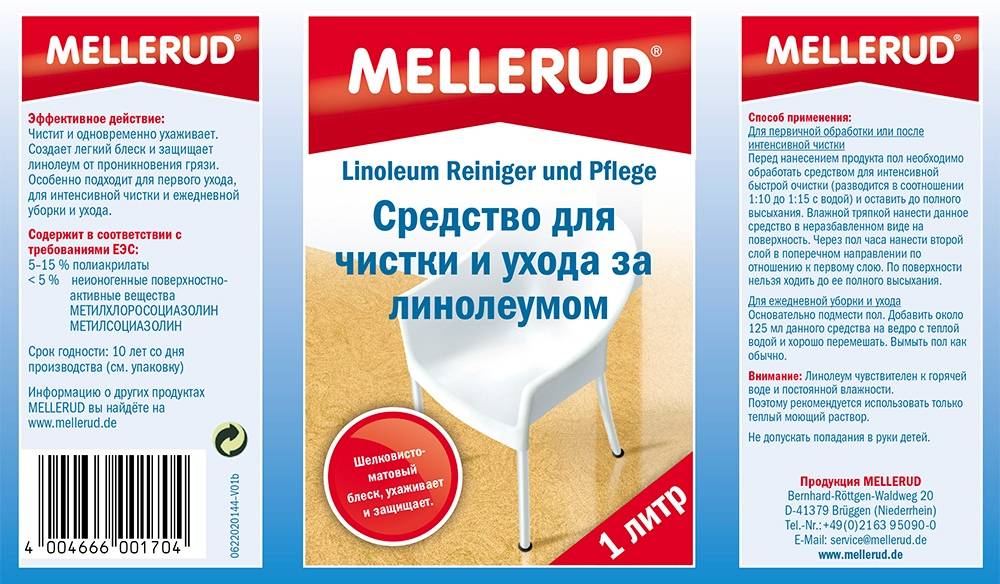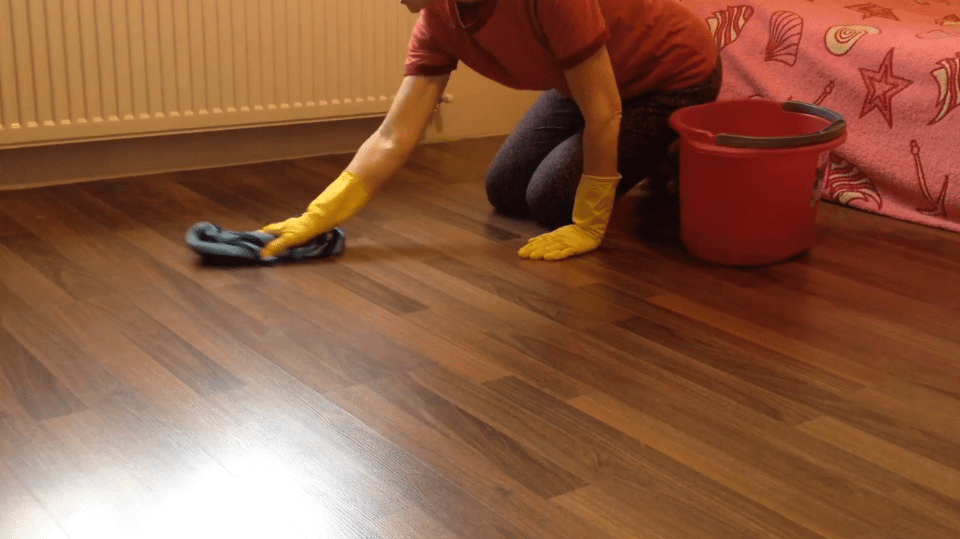How to restore shine to PVC linoleum?
PVC coatings, in contrast to natural linoleum, require more specific protection. Periodic application of a protective polymer coating will help to restore the shine to the surface and protect it from premature abrasion or loss of color. Apply it to dry linoleum free of dirt and furniture in two stages. Protect the surface from use within 10 hours after applying the protective compound.
Wax mastic is another option for bringing back the shine of the PVC linoleum surface. It should be applied at least once every two to three months (depending on the intensity of use of the room)
It is especially important to ensure the regular application of a protective layer on homogeneous linoleums, in the composition of the canvas of which there is only one layer
To wash the surface of PVC linoleum from dirt, restoring its shine, you can use a soap solution on a natural basis. But it's better to forget about aggressive cleaning chemicals. PVC coating does not tolerate contact with acids and alkalis, and instead of the desired gloss, you may well get a surface corroded by chemical attack.
The video below describes the features of caring for linoleum:
How to clean linoleum in the kitchen from all kinds of stains
There are several ways to wash very dirty linoleum:
- Ordinary dust is removed with detergents. Even white material is cleaned like that. Add 100 g of grated laundry soap to a bucket of warm water. A cloth moistened with the resulting solution is wiped off the area of contamination. Finally, wipe this area with a dry cloth.
- Greasy stains or wax are removed with high heat. A folded paper or rags are placed on the contaminated area. The heated iron is applied to the pad, as a result of which the fat is melted and absorbed into the underlay material. The remains are removed with turpentine. With this method, it is necessary to ensure that the area of the pad is larger than the surface of the iron.
- Shoe strips and shoe polish can be easily removed with regular gasoline. A cloth moistened with this solution is used to wipe the problem area.
- Stains from brilliant green are removed with hydrogen peroxide or camphor alcohol. One of these tools is used to treat the contaminated area until the trail disappears.
A few drops of gasoline or kerosene can easily cope with stains from iodine, brilliant green, coffee, felt-tip pens, paint, traces of shoe polish or machine oil. They are applied to the stain, and after 5 minutes, this place is rinsed with water.
For stains on linoleum, they use various household chemicals or improvised means that are in every home. The principle of operation is the same in all cases: a cleaning agent is applied to the dirt, after which the floor is washed first with soapy water and then with clean water and wiped with a dry flannel.
What is used in this case:
- Grease, including stubborn grease, is washed off with dishwashing detergents. Before use, the composition is diluted with water until foam is formed.
- Traces of asphalt, rubber or bitumen, felt-tip pen, pens or paint, stains from coffee or iodine, rust are washed off with gasoline, turpentine and kerosene. Before starting work, it is necessary to check the effect of the liquid on a small inconspicuous area of linoleum, otherwise you can damage its top layer and erase the drawing.
- Use an eraser to remove dark streaks from shoes and rubber. They just need to be wiped off the linoleum and washed with an all-purpose detergent.
- Stains from ink, felt-tip pens and brilliant green are removed with salt and vinegar. First, the stain is sprinkled with salt, then moistened with vinegar.After a few minutes, the salt is removed and the linoleum is washed.
- Ice will help to remove the chewing gum from the floor, which must be put on the gum, covered with a cloth so that it does not melt quickly, and after 10 minutes, remove the gum from the floor with a knife or spatula.
- Iodine stains are wiped off with a damp cloth with potato starch.
- The mold is removed with chlorine-containing substances, which are applied to the linoleum on both sides, after which it is dried.
- Fresh stains from oil and alkyd paint are removed with sunflower oil. Old stains are removed with a solution of 20 g of laundry soap, 20 g of soda and 1 liter of warm water. Another option is “646” thinner, which penetrates under the paint, after which it can be easily removed with a spatula.
- Scotch marks are removed with glass cleaner or alcohol.
- Pet urine is removed with vinegar, vodka or lemon juice diluted with water in a 1: 1 ratio.
What tools are useful for cleaning
First of all, it should be noted that the first wet cleaning of linoleum should be done no earlier than a month after laying. During this time, dirt should be disposed of with a vacuum cleaner or ordinary broom. Alternatively, you can use special wet wipes that have an antibacterial effect. Linoleum must adapt to environmental conditions.
During this period, it collects moisture from the air. If additional moisture gets on it, and this cannot be avoided during wet cleaning, then the floor covering may deform. It is not possible to rectify the situation. Therefore, virtually new flooring will have to be replaced.
When cleaning linoleum, do not use abrasive products. High temperatures, which have a detrimental effect on the flooring, should also be avoided. Wet cleaning should be done with a well wrung out cloth. It is advisable to wipe the linoleum with a pre-prepared piece of flannel after wet cleaning.
If cleaning is done daily, then by and large the actions described above should be enough to ensure that the finish coat is not only clean, but also has a shine.
Separately, I would like to say about the spots that eventually appear on linoleum. To get rid of them, you need to use special tools. Linoleum is cleaned of greasy stains using a conventional dishwashing detergent. A variety of stains can be removed using gasoline. Namely:
- stains from food coloring or coffee;
- shoe cream;
- brilliant green;
- marker;
- iodine.
This product will also help to get rid of the marks left after moving furniture. Kerosene has a similar effect. If you need to get rid of a small stain, you can use an ammonia solution. You can also try applying nail polish remover to the stain.
Linoleum should be washed with a soft mop
It is more convenient to clean linoleum with special tools. For work, you should prepare:
- a mop with rubber inserts;
- doormat;
- broom or soft brush;
- vacuum cleaner;
- pumice stone or fine sandpaper.
Special detergents for cleaning linoleum and compositions for creating a protective layer are also useful: mastic, drying oil, polish, etc. It is not recommended to use strong chemicals, but in rare cases it is allowed.
How to clean linoleum after renovation.
In order not to ask this question later, the coating must be protected in advance. In places where work with putty and plaster takes place, it is necessary to lay old bags or any other polyethylene of a suitable size. Where furniture or other bulky goods will be rearranged, it is best to use thick cardboard.
If the surface was not previously protected, then soak the traces of building mixtures well and scrape off with the blunt side of a knife or spatula. Damp mop a few times using a floor cleaner.Clean the traces of polyurethane foam with a spatula, then apply Komet to this place and rub with an abrasive sponge. Remember that this can scratch the surface, but otherwise it will be difficult to get rid of the foam.

What can not be used to wipe it?
First, let's sweep aside products not suitable for linoleum
, for example:
- Avoid hot water immediately. From her, he can swell.
- Often housewives, sharing their experiences, recommend using baking soda. And put it aside. The alkali in this product will damage the surface over time. Soda is more suitable for dishes with a smooth structure.
- Abrasives will scratch it.
- The solvents and bleaches we sometimes use to remove stains will discolor the design and, in severe cases, can leave a corroded stain right down to the base.
It turns out that everything is not so simple, I wiped it with a rag and forgot. Any thing requires proper care, linoleum is no exception. After we have removed the substances harmful in our case in the box, we will think about what can be used.
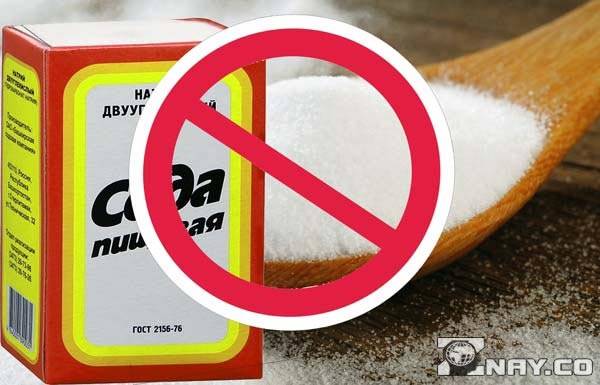
How to update the view
Even with regular maintenance, after a while, linoleum can fade and lose its attractive appearance. This happens especially often in rooms where the floor has a heavy load. For example, in the kitchen, linoleum can suffer from cooking grease splashes, food stains and other contaminants that have to be removed regularly, which can cause the print to fade and lose its shine.
To renew the surface of linoleum, wax-based mastics are used. To apply the protective layer correctly, follow these steps:
- Thoroughly wash the floor, removing dirt and removing old polish using special products.
- Wipe the washed floor dry to avoid streaks.
- Apply mastic with a roller, special mop or polishing machine.
- Allow the surface to dry for at least 10 hours.
- Vacuuming the renewed floor.
How to wash linoleum?
You need to wash linoleum as it gets dirty, but at least 2 times a month. Otherwise, the stains will penetrate deep into the structure of the material, and it will become impossible to get rid of them.
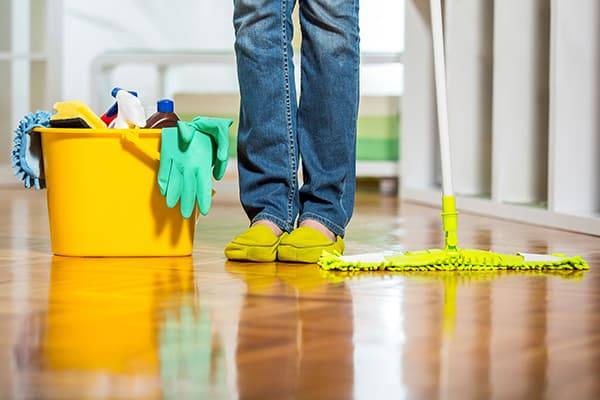
General rules
If you want to preserve the attractive appearance of the floor covering for a long time, follow 6 basic rules:
- Before damp cleaning, be sure to sweep or vacuum the floor, otherwise you will simply smear the dirt over the surface.
- Use warm water. A cold one will not help get rid of old dirt, and a hot one will wash away the protective layer and spoil the material.
- Change the water frequently to avoid spreading microbial colonies around your apartment. After cleaning the bathroom or kitchen, be sure to change the water and wash the rag with soap and water.
- Wipe off large, fresh stains immediately after they appear with a kitchen sponge.
- Before using any product from the household chemical arsenal, test it on an inconspicuous area of the floor. There are coatings that do not tolerate alkalis and acids well.
- Do not mix different products. The substances in their composition can enter into a chemical reaction with each other, which will lead to unexpected consequences.
After washing, do not wait for the linoleum to dry on its own. To prevent streaking, wipe the floor with a dry cloth or mop.
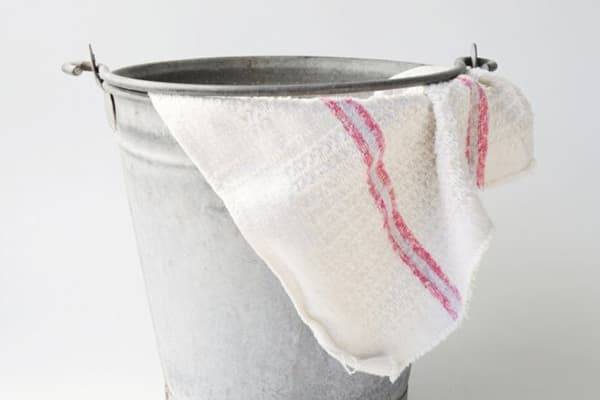
What can not be used to wash linoleum?
The internet is awash with tips on how to use folk remedies to clean linoleum. Some housewives, wanting to save money, scrub the floor with vinegar, soda or soap, and then regret it.
What can not be used to wash linoleum and why?
- Laundry soap. Contains alkali, which destroys the protective layer of the coating. Leaves white streaks on the floor. You have to wash the linoleum 2 times to achieve visual cleanliness.
- Baking soda. Not suitable for cleaning for the same reason as laundry soap - alkali.
- With vinegar. The coating does not tolerate acids well.
- Citric acid. Same problem as with vinegar.In addition, citric acid causes discoloration.
- Products with bleaching ingredients (especially chlorine). This chemistry is quite aggressive for linoleum. Bleaching agents spoil the color of the coating and destroy the top layer.
- Abrasive powders. "Pemolux", "Hostess", Comet and other similar products leave scratches on the surface.
From folk remedies, it is allowed to use milk with water in a 1: 1 ratio or potato starch (1-2 tablespoons per 10-liter bucket). But they cannot cope with heavy pollution. In addition, the floor has to be washed 2 times. Therefore, it is better to "update" linoleum at home using modern means.
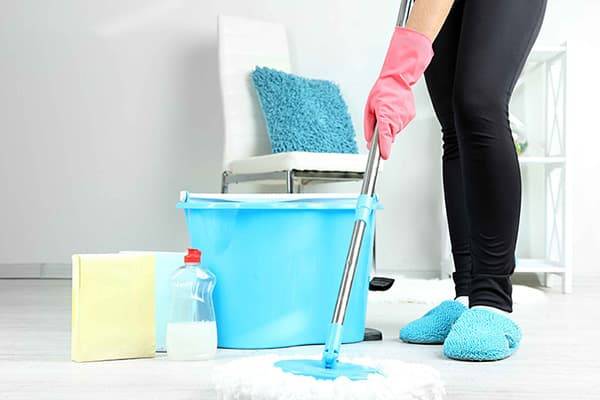
Necessary equipment
The following things are suitable for washing linoleum:
- a rag made of old rags or any soft fabric;
- mop - microfiber, with a foam tip or plastic bristles;
- steam cleaner.
When using a rag or mop, be sure to wear rubber gloves, as household cleaning products can irritate your skin. A steam generator is the most convenient way to wash linoleum, especially with a relief pattern. Only this device must be switched to mode "2" or "3" so that hot steam does not spoil the coating.
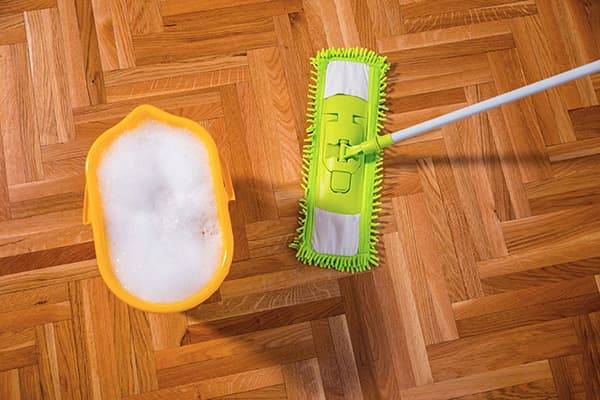
How to properly care for linoleum so that it will serve for a long time.
In order for your coating to serve you for years and at the same time retain its presentation, use simple rules:
- Use a rug in the hallway. From the sole of the boots, especially in winter, sand will constantly pour down, which will act as an abrasive, scratching the surface.
- Instead of rubber or plastic furniture pads, use felt ones, as they will not leave any residue behind.
- You should not lay linoleum in unheated rooms. In winter, at subzero temperatures, the coating loses its properties and is easily damaged.
- Try not to allow the formation of old stains, every day later it will be more difficult to remove them.
- Remember that any contact with fire can permanently ruin its appearance. And if an ordinary match dropped on the floor will not leave a trace, then here is the hookah coal, in a few seconds it burns through everything.
Times read: 902
Today: 1
Answers on questions
When caring for linoleum, questions often arise about the correct and effective cleaning of the coating. Below are the answers to some of them.
How to wash linoleum with a relief?
Linoleum with a relief is more difficult to clean than smooth. For its high-quality cleaning, the floor is poured with soapy water, left for exposure, then the water is removed with a brush, acting carefully so as not to damage the surface. A special solution for cleaning linoleum will help to effectively remove dirt. For cleaning, it is convenient to use a washing vacuum cleaner and special attachments.
Why do red spots appear on linoleum?
Red spots can accidentally appear from the fact that a food product (for example, beets) has been dropped on the floor, juice or fruit drink has been spilled, contamination may be the traces of a felt-tip pen or pen. These problems can be easily eliminated with the appropriate cleaning products. But there are more serious situations when the linoleum turns red due to damage to the upper layer of the flooring material and its partial delamination. In this case, it will not work to cover up or clean the stain, only partial or complete replacement of the coating will help.
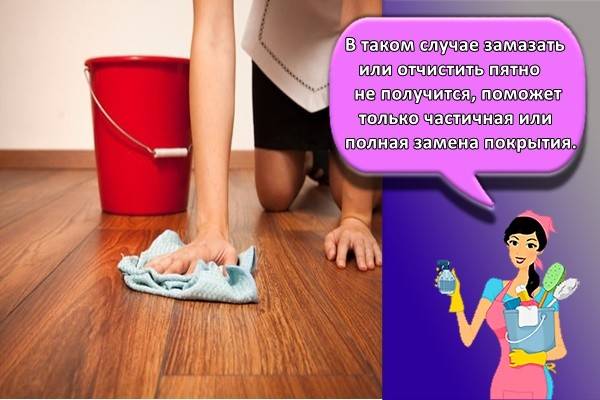
The reason for the dark spots that appear on the linoleum may be the glue on which the linoleum is placed. If they appear through the thickness of the coating, then they cannot be wiped off from the outside. It remains only to disguise them with carpet, furniture or replace this section of linoleum.
How to wipe off the stain from linoleum?
Fresh stains can be washed off with alcohol, vodka, acetone, or another solvent. If the affected area is large or the dirt is ingrained, it may be easier to neatly replace the stained linoleum by cutting it out.
How to remove yellow spots on linoleum?
Laundry soap will help with yellow spots. A solution is made from it by grating and dissolving in warm water. The contamination is wiped off with a sponge or cloth soaked in liquid, then wiped dry.
How to wipe away stains on linoleum of unknown origin?
First of all, they try to remove unknown stains with a damp cloth, then use a soap solution. If this does not help, use stronger means. You can try to get rid of unknown building stains left during the repair with a stain remover.
Linoleum has gained popularity due to the variety of colors, the ability to choose high-quality flooring material at an affordable price, and ease of maintenance. Knowing and observing the simple rules of daily cleaning, removing stains and protecting the coating, you can preserve the appearance of linoleum for a long time and extend its service life.
Share link:
Consequences of the repair
A real panic about how to wash the linoleum can overtake any housewife after the renovation is completed in the apartment. It is better to prevent the "headache" and protect the linoleum flooring with an old carpet, several layers of newspapers, polyethylene, and large-sized rags. If this has not been done, the cleaning will be long, difficult and thorough enough. The algorithm will be like this:
- dry cleaning;
- wet cleaning;
- washing "clean" using vinegar or potassium permanganate;
- drying.

Dry cleaning will consist of sweeping away dust, dirt, construction waste with a broom or brush
Dry cleaning will consist of sweeping away dust, dirt, construction waste with a broom or brush. If any building compounds are stuck to the coating, use a spatula. The next stage is wet cleaning. Here the question of how to clean linoleum floors is quite acute, because the pollution is serious. You should choose a serious professional product exclusively for linoleum: listen to the advice of a store consultant when choosing it. Get ready for the fact that the water, as well as the rag, you will change several times (at least 3). Only then can you achieve the desired effect. At the end, collect clean water again, dissolve vinegar or potassium permanganate in it and wipe the floor clean with a completely new rag.

If you do not want to carry out cleaning work by hand, then after dry cleaning, a washing vacuum cleaner for linoleum can greatly help you.
Certain difficulties may arise in the fight against polyurethane foam... Its top layer should be carefully cut off with a construction or clerical knife. The bottom layer must be moistened abundantly with water and allowed to deteriorate. Ideally, cover the foam marks with a wet rag for a few hours. The swollen mass is more easily washed off with a special tool for removing precisely the polyurethane foam. If you do not want to carry out cleaning work by hand, then after dry cleaning, a washing vacuum cleaner for linoleum can greatly help you. He will be able to really reduce the number of washes, to carry out them with significant savings in time and effort.
In the end, some tips for bringing back the shine of old linoleum flooring. To do this, you can use a folk remedy: milk added to water in a 1: 1 ratio or chilled water in which potatoes were boiled. After that, you should rub the linoleum covering with appropriate means for it protection and shine... You can use polymer mastic or polish.
How else to look after: reliable means
The best remedy for all problems is prevention:
- Immediately after laying the floor, treat it with mastic or wax, all this can be easily bought now. Such measures will help maintain shine and prevent cracking.
- Furniture is the main enemy for linoleum, it pushes it through, leaves holes that you can't get rid of later, and scratches. It has long been invented to glue pieces of felt on the legs.Do not neglect, the process may take some time to manufacture, but the furniture will not leave holes in the floor.
- The sun's rays make the drawing look dull. Cover your window shades during the daytime.
- If a hole has formed on the surface, you will have to replace the piece. Apply a new one to it, cut along the contour, degrease and apply glue. If you try and do it with pinpoint accuracy, it will turn out completely imperceptibly. In any case, you can always put a chair in this place.
It would seem that I put linoleum on the floor and there is no problem, because that is why we choose it for the home. This is true, it would be much more difficult or impossible to remove the same dirt from the carpet. The main thing here is to know what you can do to wash linoleum, and what you can't, and there really won't be any difficulties.

Video: means and methods of washing linoleum
In this video, the same Dmitry will tell you how to wash difficult stains on a floor covered with linoleum:
In case of improper or irregular maintenance, any floor covering quickly deteriorates. Linoleum is no exception. In particular, under the influence of dust grains, the protective top layer is abraded. Also, ultraviolet light and aggressive substances act negatively on coatings based on polyvinyl chloride.
Protect linoleum from exposure to burning cigarettes or matches.
When entering the house, it is best to put a rug (free of bitumen or similar materials) to protect the floor from sand, dust or mud. It also makes it easier to keep the floor clean.
Protect linoleum from frequent exposure to sunlight, as it can fade the material.
It is forbidden to drag weights along the linoleum with a drag: this breaks the coating. To move objects, you need to lift them or use wheels and rugs.
The use of chemical solvents, as well as the use of undiluted bleach, can adversely affect the condition of the material.
If you ignore the rules of caring for the floor covering, then it will wear out ahead of time, its appearance will change. If you protect the floor from excessive exposure to dust and ultraviolet radiation, prevent contact with corrosive liquids, you can preserve the freshness and beauty of the floor for a long time.
If an additional layer of protective material is applied to the coating material, then its cleaning is much easier. The fact is that such material does not need to be pre-processed. Be aware, however, that the protective coating can be vulnerable to abrasive agents or strong solvents.
Means and tools for cleaning linoleum
Before deciding what is better to wash linoleum, you should familiarize yourself with the list of mandatory tools and tools:
- Mop with rubber inserts;
- Soft cloth for cleaning floors;
- Broom or soft brush;
- Ordinary or washing vacuum cleaner;
- Special detergents for regular cleaning of linoleum;
- Means for the protective layer: mastic, drying oil, polish, etc .;
- To remove stubborn stains, you can use pumice stone or fine sandpaper;
- The use of chemicals is not recommended, but in extreme cases it is allowed.
Separately, it is worth talking about which mop is better to wash linoleum.
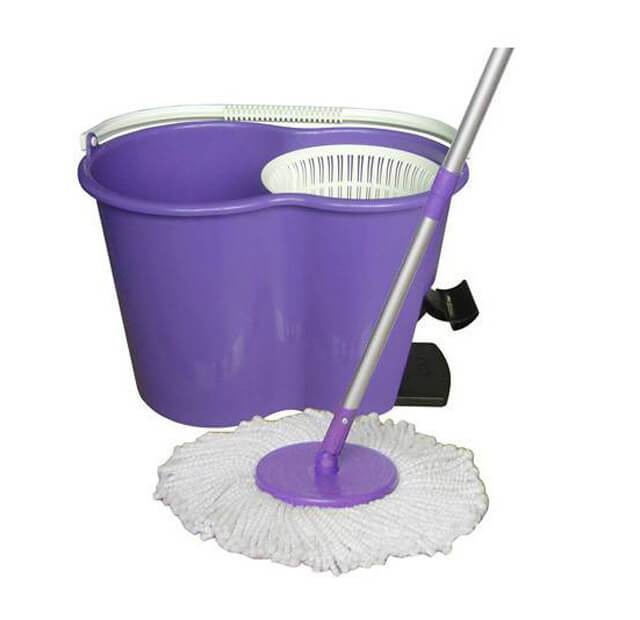
When choosing a hand mop, you should pay attention to the following details:
- The mop must have rubber inserts;
- The mop should not have any scratching parts;
- The mop must have sufficient grip.
You can see an example of a suitable mop in the photo.
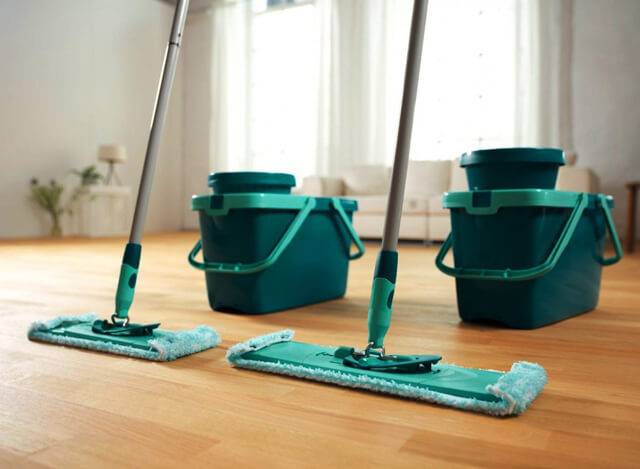
Complex pollution
Doubts about how to wash linoleum can also arise when any complex stains, deep dirt appear on the floor surface, requiring a special approach, the use of a set of measures.
If the stain remains on the surface for at least an hour, the absence of a trace of its removal will be a big question.
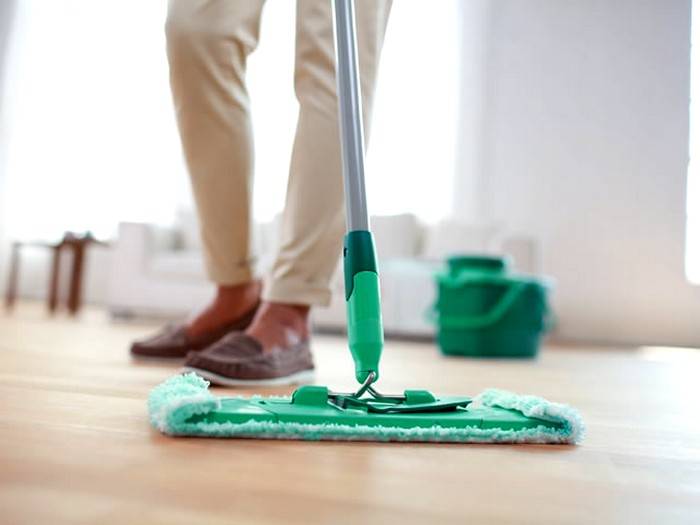
If the stain remains on the surface for at least an hour, the absence of a trace of its removal will be a big question.
So, the better to wash linoleum if its surface is dirty:
- asphalt or oil;
- wax;
- shoe polish;
- machine oil;
- coffee, iodine;
- felt-tip or pencil drawings.
There can be only one answer - gasoline, kerosene. Naturally, since these funds are distinguished by a certain degree of aggressiveness, it is impossible to pour it thickly onto the stain and keep it in order to dissolve for a long time. Here we are talking about a small amount, which is moistened with a small cloth or cotton wool. The stain is lightly wiped with gasoline until it is completely removed, and then any available detergent for linoleum, dissolved in warm water, is applied
If there are wax, shoe polish, asphalt spots on the surface, they must be first and very carefully removed with a spatula without causing mechanical damage to the linoleum
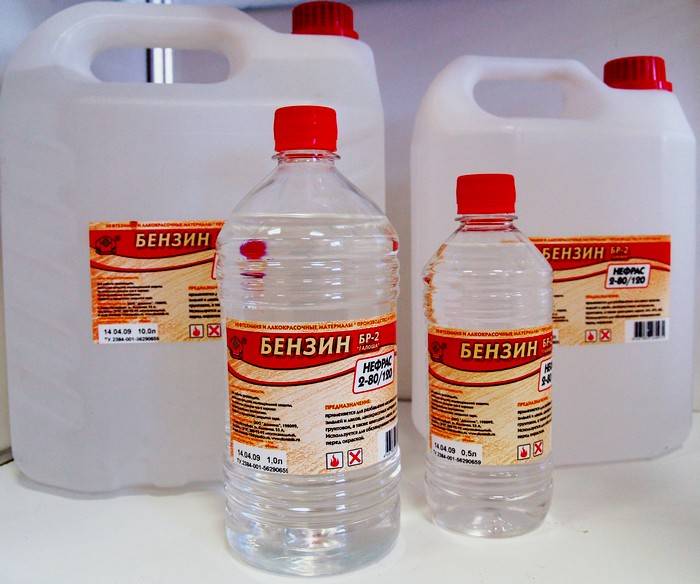
Many stains from linoleum can be removed with gasoline.
Let's talk separately about ink, for which gasoline will not be enough to remove. You will have to arm yourself with sandpaper or pumice.
If the question arises as to what is the best way to wash linoleum floors when mold, rust, a stain of any other plant origin is found on them, a special solution consisting of warm water (10 parts) and bleach (1 part) will be the way out of their situation. If it is not enough, you should use lemon juice or a slice of any other citrus fruit.
The simplest stain in the fight for shine and cleanliness is grease, which can be easily removed with a simple soapy solution. Of course, if such a stain does not belong to the category of old ones. Then you can't do without turpentine! Light plaque of any origin can also be quickly removed with any product that you use to clean the bathtub or ceramic tiles. Thinking about how to wash linoleum in the kitchen, do not forget about the main thing: regardless of the product used, be sure to rinse the floor with clean water after it (more than once, if necessary) and wipe it dry. Only then will you be able to achieve its original purity and shine.
How to wash linoleum
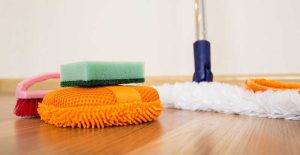
- Do not wash the floor with hot water. This leads to bloating. Either cold water or room temperature is best.
- Refrain from using baking soda. Contrary to various opinions, alkali forms microcracks on the coating, which leads to its deformation.
- Solvents, chlorine-based products, and bleaches can have an extremely negative effect on the finish. The use of such aggressive agents leads to discoloration and even destruction of the top layer of linoleum.
Before washing the linoleum, dry clean it. If there is strong dirt on the floor, special agents are applied to them and then wiped with a damp cloth.
Usually, linoleum is washed with ordinary soapy water, which you can prepare yourself. To do this, dissolve 100 grams of laundry soap in a bucket of water. This tool will also help to cope with light dirt.
You can also use dish detergent. A few drops are enough for a bucket of water.
Make sure no moisture remains. Otherwise, wipe the surface dry after cleaning.
How to wash to shine
In household chemical stores, there is a huge selection of products that are used to maintain shine. It can be mastics, polishes, waxes. The advantage of these products is that they create an additional protective layer on the coating. Some polishes can be added to the water used for cleaning floors during regular cleaning. Once every 6 months, manufacturers recommend applying a special varnish to restore the protective layer. This is often true for rooms where there is a lot of traffic - a corridor, a kitchen.
How to wash without streaks
Floor stains are annoying for any housewife.In order to avoid them, it is not recommended to wash the floor with a strong soapy solution. And detergents should be added strictly according to the instructions. The most common reason that leads to divorce is excessive use of foam.
If stains do form, the surface should be washed with clean water without adding any detergents. The procedure must be repeated until the remains of the detergent are washed off.
How to wash off whitewash

- Always start with dry cleaning. Dust and small debris should be removed with a vacuum cleaner or broom. Otherwise, cleaning will not be as effective - you will only smear the dirt on the floor.
- The floor is washed with clean water without adding any products. The procedure is repeated several times until the expected result.
- The water in the bucket should be changed as often as possible. If necessary, the rag is also changed during the washing process, since not every material can be rinsed out.
- After finishing the floor is wiped dry with a clean cloth and rubbed with a special polish or mastic.
We wash away stains of various origins
To keep the floor clean, it is not enough just to wash the linoleum from the stubborn dirt, it is also necessary to remove the stains. Their origin is different, respectively, and the means for removal are different.
Dark streaks and spots. They remain after shoes with dark rubber soles or something similar. They can be removed:
white school eraser (color can change the color of the coating);
toothpaste (again, white);
universal tool WD-40. Spray on the stain and rub. Wash off with soapy water and wipe dry.
Zelenka. We take cotton sponges and alcohol. We moisten the stain, wipe it. Try not to rub, otherwise it "spreads". For the same reason, do not pour alcohol on the stain - it will become lighter, but larger in size. Camphor alcohol on some coatings does a great job.
Iodine
Hydrogen peroxide, toilet cleaners (acidic or bleach-based, but be very careful with chlorine) can help. Dilute the soda to the state of gruel, put it on the stain, on top - a piece of polyethylene, on it - a rag
Wash it off after a few hours. You can use potato starch in the same way.
Painting with felt-tip pen, marker, pen. If markers and felt-tip pens are ordinary - water or alcohol, then just water and soap or a cotton pad moistened with alcohol will help. If we are talking about permanent (indelible) markers and felt-tip pens, then you can try:
Solvents (for varnish too, for shellac).
Acetone.
Industrial alcohol, alcohol wipes.
Deodorant spray. Apply, wait a couple of minutes and wipe off.
OXY 10 acne remedy. Apply for a long time - at night, then wash off. They say it discolors.
Sprite (colorless). Pour the stain overnight, wipe off in the morning.
Hair fixation spray. Sprinkle, wait 5 minutes, wash. It may need to be repeated several times.
Moment of Anticlea. Special glue remover, helps with super permanent markers.
Tea tree oil.
Means for dry car cleaning. Apply, wait as long as it is written in the instructions and rinse.
Sulfur-headed matches. Moisten in water and rub with sulfur.
Melamine sponge. The sponge is abrasive, so three without fanaticism and use it as a last resort.
When choosing a remedy, try to start with the most harmless one. Increase the "harmfulness" gradually. After each treatment, wash well with water, wipe dry. Otherwise, the linoleum may give up earlier than the stain.

